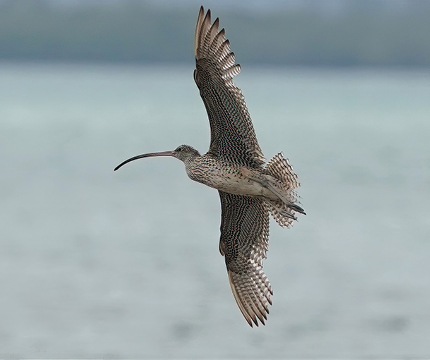Shorebirds
The Southeast coastline is the most populated stretch of coastline in Queensland. The region hosts significant numbers of shorebirds including the vulnerable Beach stone-curlew. Many of the shorebirds you will see on the Fraser Coast have travelled thousands of kilometres since breeding in the Arctic. Between August and May, an estimated 45,000 birds visit the region to rest, feed and replenish fat reserves for their return journey.
The waters of the Fraser Coast, including the Great Sandy Strait, protects tidal wetlands, important habitats for shorebirds. During summer, numbers of shorebirds in the region can swell to 30,000 when migratory species join resident birds to share the area between land and sea. These shorebirds need space, food and protection at critical staging sites along their foreshore habitat.
The threats to shorebirds include habitat loss/destruction, climate change, rubbish, human disturbance and predators such as dogs. Migrating shorebirds roost and feed on the beaches. Even minor disturbances can use up critical energy reserves needed for the long flight to their breeding grounds in the Northern Hemisphere.
To protect shorebirds, Council asks residents and visitors to our region to adhere to the following:
- Observe them from a distance
- Keep dogs at a safe distance and on a leash
- Properly discard fishing equipment and retrieve any you find
- Reduce your use of plastic and dispose of it properly
Whilst many shorebirds visit from afar, others live and breed within Australia. Some of the resident shorebirds found on the Fraser Coast include:

Image provided by Cecile Espigole
Pied Cormorant (Phalacrocorax varius)
Also known as the Yellow-faced cormorant, this bird can often be seen drying its wings after underwater feeding. It is a strong swimmer with a sharply hooked bill for catching fish.
Status: Secure

Image provided by Cecile Espigole
Beach Stone-curlew (Esacus magnirostris, formerly known as Esacus neglectus)
This large wader has a strong, black-tipped yellow bill, a prominent black and white eye stripe and is most active at dusk, dawn and night. The Beach Stone-curlew lays a single egg on the sand, usually in a vulnerable position, just above the high tide mark.
Status: Vulnerable

Image provided by Cecile Espigole
Sooty oystercatcher (Haematopus fuliginosus)
A sturdy sooty black wader with a scarlet bill and pinkish legs. It prefers rocky shoreline and coral reef habitats, breeding mostly on offshore islands. It lays 2-3 eggs in the sand, among rocks, seaweed, pigface and shells.
Status: Secure
Many of the shorebirds seen on the Fraser Coast have travelled thousands of kilometres since breeding in the Arctic. Between August and May, an estimated 45,000 birds visit the region to rest, feed and replenish fat reserves for their return journey. Some of the migratory species which visit the Fraser Coast are:

Image provided by Cecile Espigole
Eastern Curlew (Numenius madagascariensis)
At up to 63cm, the Eastern Curlew is the world’s largest shorebird. It has a long down-curved bill, which is used to probe the mud and dig up crabs. The Eastern Curlew lays 2-4 eggs.
Status: Vulnerable

Image provided by Cecile Espigole
Lesser sand plover (Charadrius mongolus)
The Lesser sand plover breeds in central and north-eastern Siberia. It forages on mud, sand or open areas of long grass and gathers at high tide roosts with other waders.
Status: Least Concern

Image provided by Cecile Espigole
Whimbrel (Numenius phaeopus)
The Whimbrel is a medium-sized curlew, up to 42cm in size. It has a long down-curved bill with a pink lower base. The Whimbrel has a white lower body with coarsely streaked brown upperparts. They lay 2-4 eggs.
Status: Secure
Fast facts! Many birds travel 25,000 km each year, with some larger species flying 11,000 km non-stop. Even those birds weighing as little as 30 g (two 50 cent pieces) fly these incredible distances. By the time these birds reach their breeding grounds in the Arctic, they may have lost up to 40 percent of their body weight.
Shorebirds can change their body feathers at least twice a year. Once when they attain a colourful breeding plumage, and then again when they attain a plain winter plumage.
